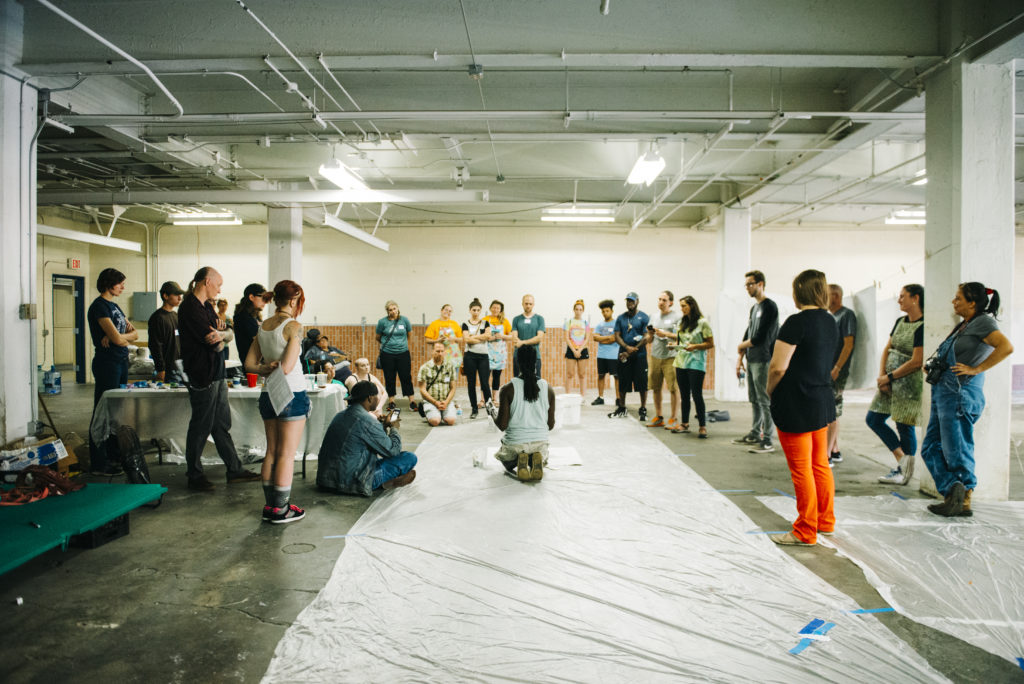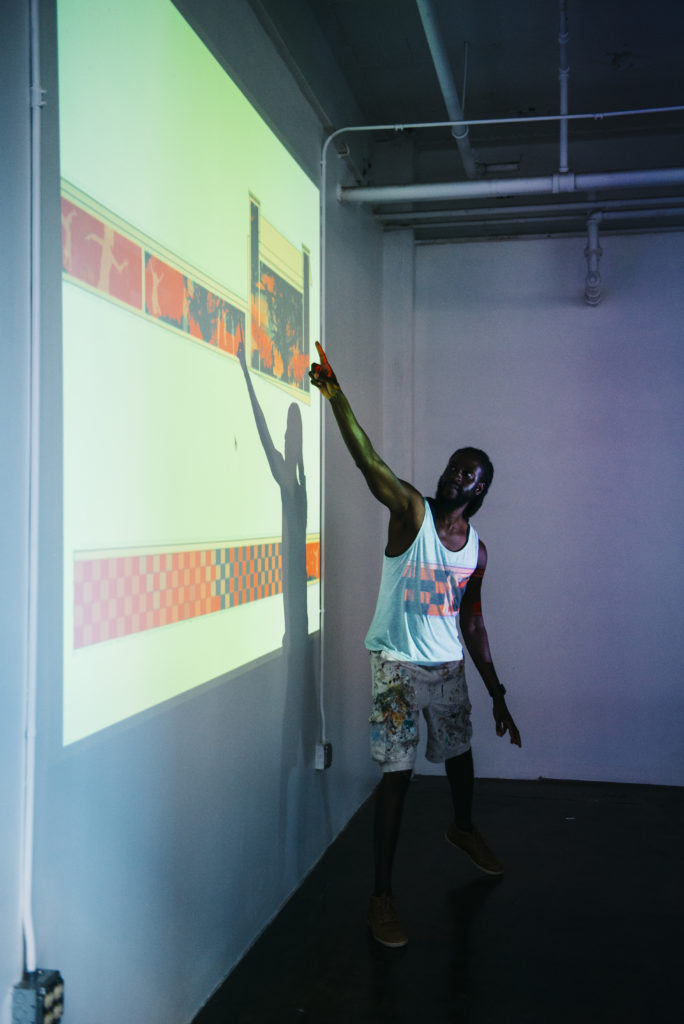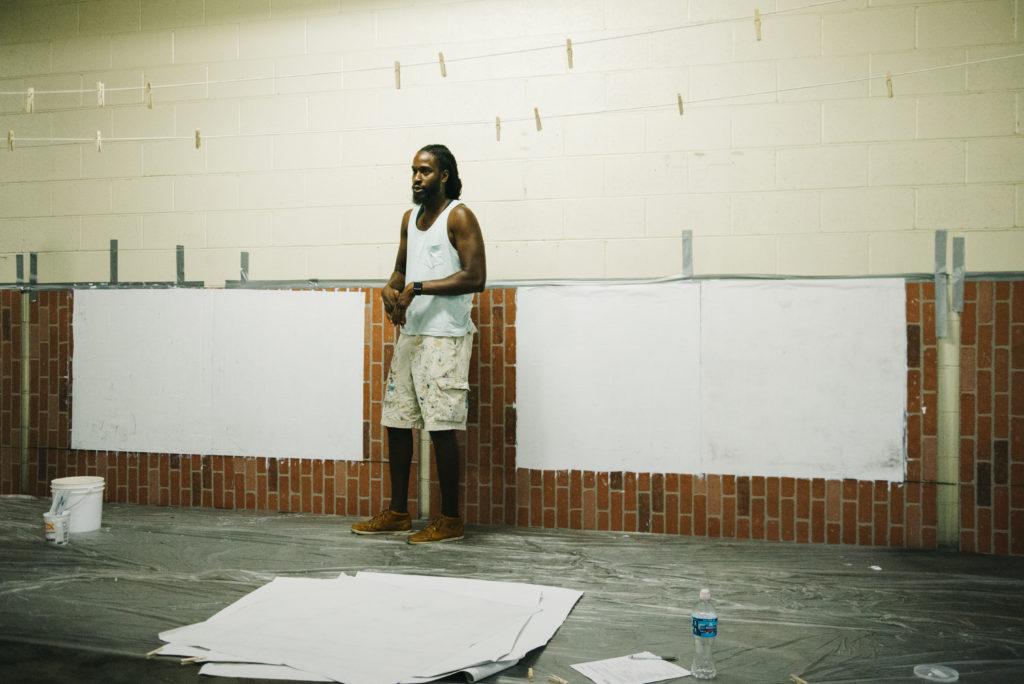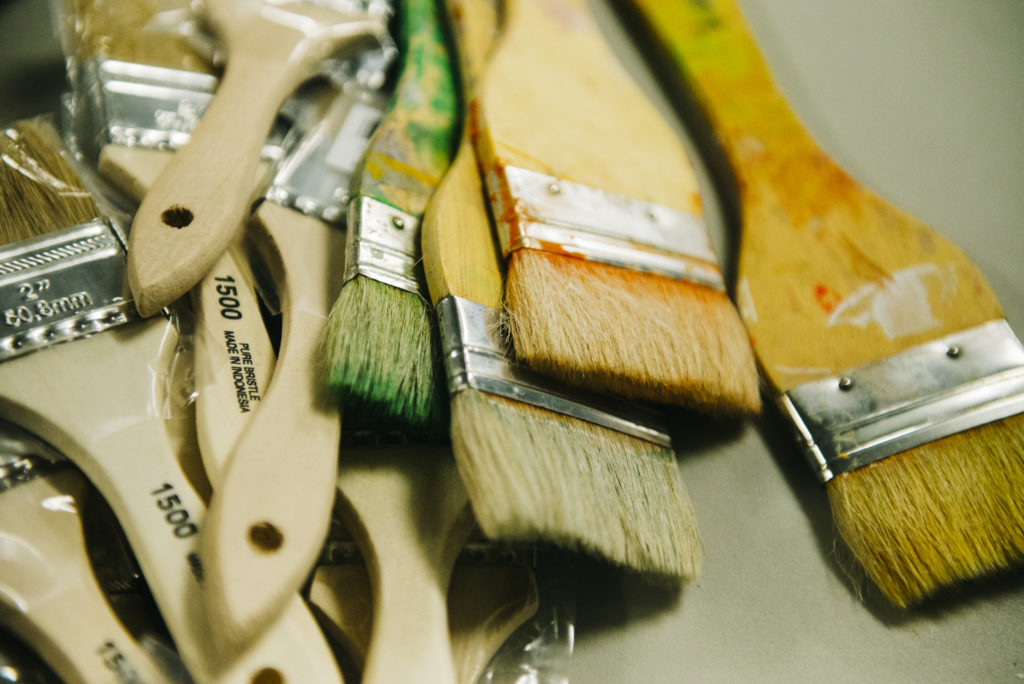Mural Making Workshop
Guest writer: Ilenia Pezzaniti
📷: Ilenia Pezzaniti

On August 8, in conjunction with Mural Arts Philadelphia, ArtsNow held a mural making workshop at Bounce Innovation Hub as part of the Phase Two initiative of the Park East Project. The workshop specifically targeted how and why to work with parachute cloth, the same medium chosen for the current mural installation painted by Artist-In-Residence Lizzi Aronhalt that will be on display August 23.
Sharon Connor, 61, was an attendee who works at Miller South School and runs a nonprofit in Goodyear Heights. Connor who grew up in Philadelphia and has been familiar with the Philadelphia Mural Arts program for a number of years said, “I love this technique. We actually did a mural in Akron using this same technique. It’s at the Linda Theatre in Goodyear Heights and so I was familiar with this, but it’s fun to see it in process and it’s fun to watch other people learn that process.”
The event was open to the public for a fee. The workshop presentation and hands on experience was provided by Mural Arts Philadelphia Staff Mural Artist Felix St. Fort and Mural Project Manager Aislinn Petecost-Farren.

A total of 28 people interested in mural making attended the three hour workshop. For the first half hour, attendees met one another and enjoyed dinner and beverages together. Afterward, the curious artists and community members gathered around St. Fort as he gave a comprehensive presentation of mural making and his experiences, complete with what not to do’s.

David Palmer, 43, who does a lot of painting, used to wheat paste ads, wallpaper and paint houses, was interested in the workshop to learn about the application of different mediums. “I just moved here from another city where everyone I know is a painter and we all dispersed to different cities. My mom got me out here and she was like, ‘Oh, well why don’t you try something different?’”
Among a plethora of information, guests learned that parachute cloth is an advantageous method of mural making and installation because it’s more flexible, you don’t have to paint directly onto the wall, it’s cost effective, and possibly the greatest benefit: the creator can paint it in small sections in studio.
Thirty four year old artist, Scot Philips, who has been a mural artist for 10 or 12 years, found the parachute cloth approach appealing. “It’s a lot more doable and a lot more permanent than I thought. I come from a traditional background where if you want a mural on a wall you paint it. I was like, ‘I don’t know about this attaching, what I thought was a piece of canvas, to a wall and it lasting.'”
“I’m always the guy that’s up on a lift in 90-degree weather painting for a month so the idea of parachute cloth really opens up some possibilities for me to work in a way that allows both the property owners and myself to facilitate that schedule, be more efficient, and get more jobs done… I think this really would facilitate me being in my studio and not out on a lift which is very expensive,” he added.

After the presentation, participants were led upstairs to the 5th floor where Aronhalt created the Phase Two mural on parachute cloth, to engage themselves with the parachute cloth and tools and the methods necessary for a successful installation. St. Fort and Petecost-Farren taped faux brick to the walls to give the attendees a taste of real world experience and potential issues for which they would need to problem solve. St. Fort then demonstrated the materials using humor and past experiences that humanized what can seem like an overwhelming task.

Jenny Hitmar-Shankland, 41, who has a theatre painting background and lives in Cleveland, traveled to Akron for the workshop because she wanted to be better prepared for future mural-making jobs. Hitmar-Shankland had some previous experience with learning the parachute cloth method but was happy to learn what to use. “I like knowing specific materials. If somebody who’s used something for 10 years can tell me that a specific material works then it’s invaluable rather than having to test different things.”
Attendees were partnered up and traded on and off gelling the faux brick walls and parachute cloth, working together to pin the cloth to the wall. Each person got to try their hand at the proper way to maneuver a squeegee to remove excess gel and smooth air bubbles by using their entire body, not just their arms.

Daniel St. Surin, 19, who did a project on the city of Philadelphia that got him interested in the city itself said, “It’s definitely a lot harder than people might think it is. We plan on traveling to Philadelphia sometime soon and it’ll definitely make me appreciate the art a lot more. Like what goes into it, not just painting it and putting it up but also the process of putting it on the wall.”
Before the workshop ended, St. Fort went around the room assessing and critiquing each 5’ x 5’ installation. Participants left with a sense of confidence.
Katie Jordan, 19, a painter and future Kent State University art student, wondered how to begin proportioning things. “When you’re doing it up close (drawing) it’s smaller and you can see the whole big picture but when you’re doing it on a wall it’s a whole bigger scale so you have to keep stepping back… And this totally makes sense on how you can grid something and put it all together in a final product so that’s really cool that maybe I could potentially do this one day. I liked learning about how to do it and the steps that they took.”

